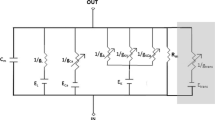Abstract
Pigeon vestibular semicircular canal type II hair cells often exhibit voltage oscillations following current steps that depolarize the cell membrane from its resting potential. Currents active around the resting membrane potential and most likely responsible for the observed resonant behavior are the Ca++-insensitive, inactivating potassium conductance I A (A-current) and delayed rectifier potassium conductance I K. Several equivalent circuits are considered as representative of the hair cell membrane behavior, sufficient to explain and quantitatively fit the observed voltage oscillations. In addition to the membrane capacitance and frequency-independent parallel conductance, a third parallel element whose admittance function is of second order is necessary to describe and accurately predict all of the experimentally obtained current and voltage responses. Even though most voltage oscillations could be fitted by an equivalent circuit in which the second order admittance term is overdamped (i.e., represents a type of current with two time constants, one of activation and the other of inactivation), the sharpest quality resonance obtained with small current steps (around 20 pA) from the resting potential could be satisfactorily fit only by an underdamped term.
Similar content being viewed by others
References
Art JJ, Fettiplace R (1987) Variation of membrane properties in hair cells isolated from turtle cochlea. J Physiol (Lond) 385:207–242.
Ashmore JF (1983) Frequency tuning in a frog vestibular organ. Nature (Lond) 304:536–538.
Ashmore JF, Attwell D (1985) Models for electrical tuning in hair cells. Proc R Soc Lond B 226:325–344.
Bobrow LS (1981) Elementary linear circuit analysis. Holt, Rinehart and Winston, New York.
Correia MJ, Christensen BN, Moore LE, Land DG (1989) Studies of solitary semicircular canal hair cells in the adult pigeon. I Frequencyand time-domain analysis of active and passive membrane properties. J Neurophysiol 62:924–934.
Crawford AC, Fettiplace R (1980) The frequency selectivity of auditory nerve fibers and hair cells in the cochlea of the turtle. J Physiol (Lond) 306:79–125.
Crawford AC, Fettiplace R (1981) An electrical tuning mechanism in turtle cochlear hair cell. J Physiol (Lond) 312:377–412.
Driscoll FF (1973) Analysis of electric circuits. Prentice Hall, New York.
Fishman HM, Poussart DJM, Moore LE, Siebenga E (1977) K+ conduction description from the low frequency impedance and admittance of squid axon. J Membr Biol 32:255–290.
Fuchs PA, Evans MG (1988) Voltage oscillations and ionic conductances in hair cells isolated from the alligator cochlea. J Comp Physiol 164:151–163.
Fuchs PA, Nagai T, Evans MG (1988) Electrical tuning of hair cells isolated from the chick cochlea. J Neurosci 8:2460–2467.
Hodgkin AL, Huxley AF (1952) A quantitative description of membrane current and its application to conduction and excitation in nerve. J Physiol (Lond) 117:500–544.
Housley GD, Norris CH, Guth PS (1989) Electrophysiological properties and morphology of hair cells isolated from the semicircular canal of the frog. Hearing Res 38:259–276.
Hudspeth AJ (1982) Extracellular current flow and the site of transduction by vertebrate hair cells. J Neurosci 2:1–10.
Hudspeth AJ (1985) The cellular basis of hearing: the biophysics of hair cells. Science 230:745–752.
Hudspeth AJ, Lewis RS (1988) A model of electrical resonance and frequency tuning in saccular hair cells of the bull-frog, Rana Catesbeiana. J Physiol (Lond) 400:275–297.
Johnson JR (1970) Electric circuits. Part 2: Alternating current. Holt, Rinehart and Winston, New York.
Lang DG, Correia MJ (1989) Studies of solitary semicircular canal hair cells in the adult pigeon. II voltage-dependent ionic conductances. J Neurophysiol 62:935–945.
Lewis RS, Hudspeth AJ (1983) Voltageand ion-dependent conductances in solitary vertebrate hair cells. Nature (Lond) 304:538–541.
Mauro A, Conti F, Dodge F, Schor R (1970) Subthreshold behavior and phenomological impedance of the squid giant axon. J Gen Physiol 55:497–523.
Nelder JA, Mead R (1965) A simplex method for function minimization. Computer J 7:308–313.
Ogata K (1970) Modern control engineering. Prentice-Hall, Englewood Cliffs, NJ, pp 228–242.
Ohmori H (1989) Mechanoelectric transduction of the hair cell. Jpn J Physiol 39:643–657.
Pahapill PA, Schlichter LC (1990) Modulation of potassium channels in human T lymphocytes: effects of temperature. J Physiol (Lond) 422:103–126.
Pitchford S, Ashmore JF (1987) An electrical resonance in hair cells of the amphibian papilla of the frog. Hearing Res 27:75–83.
Sugihara I, Furukawa T (1989) Morphological and functional aspects of two different types of hair cells in the goldfish sacculus. J Neurophysiol 62:1330–1343.
Author information
Authors and Affiliations
Rights and permissions
About this article
Cite this article
Angelaki, D.E., Correia, M.J. Models of membrane resonance in pigeon semicircular canal type II hair cells. Biol. Cybern. 65, 1–10 (1991). https://doi.org/10.1007/BF00197284
Received:
Accepted:
Issue Date:
DOI: https://doi.org/10.1007/BF00197284




